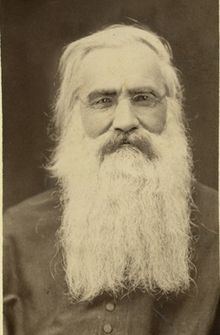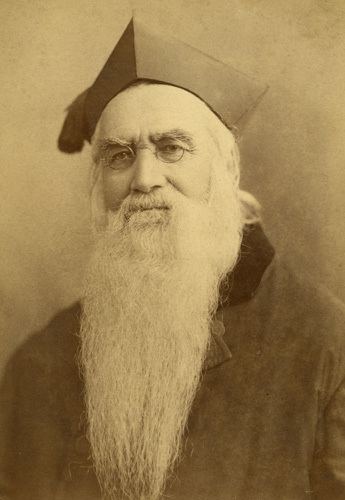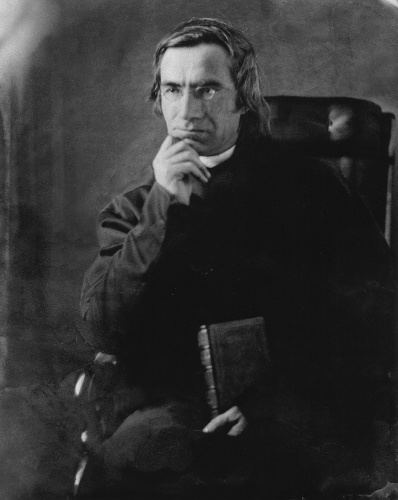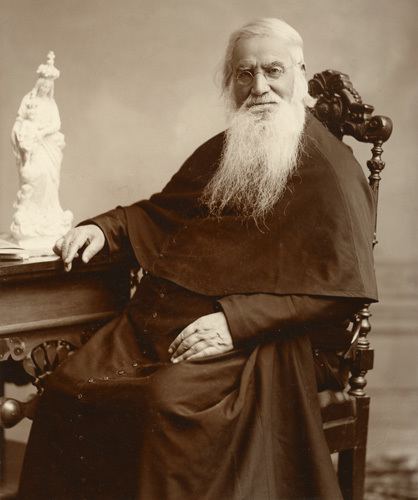Succeeded by Patrick Dillon Name Edward Sorin Religion Catholic | Profession Priest Full Name Edouard Sorin Role Priest | |
Born February 6, 1814Ahuille, Mayenne, France ( 1814-02-06 ) Resting place Holy Cross Cemetery, Notre Dame, IN Parents Marie Anne Louise Gresland de la Margalerie, Julian Sorin de la Gaulterie Books Chronicles of Notre Dame du Lac Similar People John I Jenkins, Martin Naughton, J Christopher Reyes, Condoleezza Rice | ||
The Magnificent Six: The Early Years of Holy Cross in the United States
Edward Frederick Sorin, C.S.C. (February 6, 1814 – October 31, 1893), a priest of the Congregation of Holy Cross, was the founder of the University of Notre Dame in Indiana and of St. Edward's University in Austin, Texas.
Contents
- The Magnificent Six The Early Years of Holy Cross in the United States
- Founders Day In Celebration of Notre Dames Father Sorin
- Youth
- Missionary to America
- Founding of the University of Notre Dame
- Later Years
- Founding of St Edwards University
- References

Founder's Day: In Celebration of Notre Dame's Father Sorin
Youth

Edouard Frédéric Sorin was born February 6, 1814, at Ahuillé, near Laval, France. His early education was directed by his mother, known for her intelligence and virtue. After completing his classical studies, his vocation for the priesthood being marked, M. Sorin entered the diocesan seminary, where he was distinguished for superior ability and exemplary life. Among his fellow students was the future Cardinal Langénieux.
Missionary to America

At the time of Sorin's ordination, glowing reports of missionary enterprise in foreign lands had fired afresh the hearts of French clergy, and inspired numerous vocations, not a few of which were those of future martyrs, particularly in China and Japan. It was to the first of these countries that the Abbé Sorin felt attracted; and to the end of his long life accounts of the trials and triumphs of Chinese missionaries had for him a singular fascination. He was influenced by circumstances to enroll himself in the Congregation of Holy Cross, a community of priests, brothers, and sisters lately founded at Le Mans by the Blessed Basil Moreau. The need of missionaries in the United States, so earnestly represented in letters from bishops in this country and in addresses by others who had occasion to visit Europe, was not to be disregarded by the heads of religious orders; and although France had not as yet recovered from the effects of the Revolution, she generously contributed men and means for the support and spread of American missions. Sorin, but recently ordained, was selected by his superiors to establish the Congregation of Holy Cross in what was then considered a remote district of the United States.
Founding of the University of Notre Dame
Accompanied by six brothers, he arrived in New York in the autumn of 1841, and immediately set out for Indiana, which was destined to be the field, the center rather, of his apostolate for upwards of half a century. After a short stay at St. Peter's in the Diocese of Vincennes, he proceeded northward with five of his confreres. At the age of 28, in the beginning of an exceptionally rigorous winter, in poverty and privation, on November 26, 1842, Sorin began the foundation of Notre Dame. Fr. Sorin and his Holy Cross brothers took possession of 524 snow-covered acres that the Bishop of Vincennes had given them in the Indiana mission fields and named his fledging school in honor of Our Lady, in his native tongue of French, “L’Université de Notre Dame du Lac” (The University of Our Lady of the Lake). Sorin, following Moreau’s example, sent out priests and brothers to found other schools and parishes throughout the United States and Canada. On Jan. 15, 1844, the Indiana legislature officially chartered the University of Notre Dame. It would be fair to say that as of 1844 and for many years thereafter, the designation of Notre Dame as a "University," as that term is understood today, was more aspirational than descriptive. Sorin himself, being the product of the French seminary system and by temperament more of an administrator than an academic or intellectual, was content to run Notre Dame on the model of a French boarding school, which included elementary (the "minims"), preparatory, and collegiate programs, as well as a manual training school. Over the years, however, he accepted the recommendations of others, including Fr. John A. Zahm, C.S.C., to strengthen Notre Dame's academic curriculum.

Sorin’s indomitable will was best demonstrated in 1879 when on April 23 a disastrous fire destroyed the Main Building, which housed virtually the entire university. Following the pledge made by William Corby, C.S.C., then the university's president, that Notre Dame would reopen for the fall term, Sorin willed Notre Dame to rebuild and continue its growth. As recounted in Notre Dame: 100 Years (1942), "The sixty-five year old man walked around the ruins, and those who followed him were confounded by his attitude. Instead of bending, he stiffened. There was on his face a look of grim determination. He signaled all of them to go into the church with him."
Timothy Edward Howard has provided a first-person account of what Sorin said inside Sacred Heart Church: "I was then present when Father Sorin, after looking over the destruction of his life-work, stood at the altar steps of the only building left and spoke to the community what I have always felt to be the most sublime words I ever listened to. There was absolute faith, confidence, resolution in his very look and pose. 'If it were ALL gone, I should not give up!' were his words in closing. The effect was electric. It was the crowning moment of his life. A sad company had gone into the church that day. They were all simple Christian heroes as they came out. There was never more a shadow of a doubt as to the future of Notre Dame."
An alternative version of Sorin's post-fire address to the community has gained currency in recent years, which has him saying that it was Our Lady herself who had burned down the Main Building because he had built it too small, and that he would now rebuild it "bigger and better than ever." This version seems apocryphal, however, since it was not included in any contemporaneous accounts of the event, nor can it be found in Sorin's own writings. Admittedly Sorin did detect a divine hand in the fire's origins, but ascribed it directly to God, whom Sorin suspected of being angry over "infidelity" and "neglect," not the dimensions of the building.
Sorin did have an ambitious goal for the new Administration Building that was constructed over the summer of 1879. He wanted it to be nothing less than a "monument to Catholicism." Having stood for some 135 years, the Administration Building with its Golden Dome has indeed served as a monument, if not to Catholicism generally then at least to millions of working-class first- and second-generation American Catholics who aspired to see their sons (and eventually daughters) pursue higher education as the way to gain entry into the mainstream of American social, economic, and political life.
It is a far cry from Indiana to India; but the flourishing mission in Eastern Bengal, in charge of the Congregation of Holy Cross, owes much of its success to Father Sorin's ardent zeal and active co-operation. Thither he sent its former bishop and other priests whose services could ill be spared, together with a band of sisters, the superior of whom, a native of New York, died at her distant post, a victim of her self-sacrifice. The founding of the Congregation of the Sisters of the Holy Cross in the United States is rightly regarded as one of Sorin's most important services to religion. Under his administration and care, this community, at first a handful, has become a host, with flourishing establishments in a dozen states. During the American Civil War, thanks to Sorin's forethought, this sisterhood was able to furnish nearly eighty nurses for sick and wounded soldiers on transports and in hospitals. A number of priests of the Congregation of Holy Cross, among them Fr. William Corby, C.S.C., served as chaplains at the front. Another of Sorin's many claims to the grateful remembrance of English-speaking Catholics is the Ave Maria Press, which he founded in 1865.
Later Years
Sorin was elected superior-general of his order in 1868, and held this important office during the rest of his life. During his tenure as Superior General, Fr. Sorin made around 50 voyages across the Atlantic to deal with the affairs of the Congregation in France and Rome. He was invited to attend the Plenary Council of American Bishops at Baltimore in 1884, and Cardinal Gibbons, two other archbishops, and 12 bishops attended his golden jubilee celebration in 1888. In recognition of his work in educational lines, the French Government conferred upon him the insignia of an Officer of Public Instruction (1888). Soon after the celebration of his sacerdotal golden jubilee (the same year), the venerable founder of Notre Dame entered upon a long period of mental and physical suffering, which closed with a peaceful and painless death of Bright's Disease at the University of Notre Dame on the eve of All Saints', October 31, 1893.
Founding of St. Edward's University
Sorin also founded St. Edward's University in Austin, Texas. When Bishop Claude Marie Dubuis of the Diocese of Galveston learned of Mrs. Mary Doyle's intention to leave her large South Austin farm to the Catholic Church to establish an "education institution", he invited Father Sorin to Texas in 1872. Answering the bishop's invitation, Father Sorin traveled to Austin and surveyed the beauty of the surrounding hills and lakes. A year later, following Mrs. Doyle's death, he founded a Catholic school called St. Edward's Academy in honor of his patron saint, Edward the Confessor and King. In the fledgling institution's first year, 1878, three farm boys made up the student body and met for classes in a makeshift building on the old Doyle homestead. In 1885, the academy secured its charter as a college. Sorin Hall and nearby Sorin Oak — the largest oak tree in Austin — are named after him.
